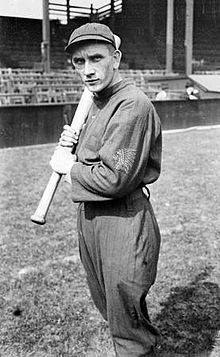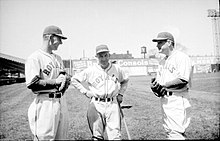Rabbit Maranville
| Rabbit Maranville | |
|---|---|
 Maranville in 1914 | |
| Shortstop / Second baseman / Manager | |
| Born: November 11, 1891 Springfield, Massachusetts, U.S. | |
| Died: January 6, 1954 (aged 62) Woodside, New York, U.S. | |
Batted: Right Threw: Right | |
| MLB debut | |
| September 10, 1912, for the Boston Braves | |
| Last MLB appearance | |
| September 29, 1935, for the Boston Braves | |
| MLB statistics | |
| Batting average | .258 |
| Hits | 2,605 |
| Home runs | 28 |
| Runs batted in | 884 |
| Stats at Baseball Reference | |
| Teams | |
As player
As manager | |
| Career highlights and awards | |
| |
| Member of the National | |
| Induction | 1954 |
| Vote | 82.9% (14th ballot) |
Walter James Vincent "Rabbit" Maranville (November 11, 1891 – January 6, 1954) was an American professional baseball shortstop, second baseman and manager. He played in Major League Baseball (MLB) for the Boston Braves, Pittsburgh Pirates, Chicago Cubs, Brooklyn Robins, and St. Louis Cardinals between 1912 and 1934. At the time of his retirement in 1935, he had played in a record 23 seasons in the National League, a mark which was not broken until 1986 by Pete Rose.[1]
Maranville was inducted into the Baseball Hall of Fame in 1954, mainly on the strength of his defensive abilities.[2]
Career
[edit]Maranville finished third in the MVP voting in his first full season, playing for the Boston Braves as a 21-year-old in 1913 even though his batting average was just .247 in 143 games with two homers. The following year, Maranville was the runner-up in the MVP voting to teammate Johnny Evers as the Braves won the National League pennant and then went on to sweep the powerful Philadelphia A's in the World Series. That year, Maranville was the Braves' cleanup hitter, despite batting just .246 and hitting four home runs. Following the series, he and several of his teammates went on a vaudeville tour, reenacting plays from the World Series while also singing and telling stories. Maranville was demonstrating a stolen base to an audience in Lewiston, Maine, when he accidentally slid off the edge of the stage and fell onto a drum in the orchestra pit, suffering a broken leg.[3] Maranville played only 11 games in 1918, spending most of the year in the United States Navy during World War I.[4]

Maranville threw and batted right-handed; he stood 5 ft 5 in (1.65 m) tall and weighed 155 lb (70 kg). Over a lengthy career which spanned both the dead ball and live-ball era, he played for the Boston Braves (1912–1920, 1929–1933, 1935), Pittsburgh Pirates (1921–1924), Chicago Cubs (1925), Brooklyn Robins (1926) and St. Louis Cardinals (1927–1928). He retired having compiled a .258 batting average, 2,605 hits, 1,255 runs, 28 home runs, 884 RBI and 291 stolen bases. As a shortstop, he finished his career with a positional record 5,139 putouts.[5] He moved to second base in 1924 after the Pirates installed Glenn Wright at the shortstop position.[4] He won his only World Series championship in 1914 as a member of the Braves, and won his only other National League championship in 1928 as a member of the Cardinals.
Maranville was known as one of "baseball's most famous clowns" due to his practical jokes and lack of inhibitions.[6] He used to don a pair of glasses to make fun of umpires and mimic the actions of hitters or pitchers who took an especially long time to get ready.[4] Other stunts he pulled included throwing firecrackers, stepping out on hotel ledges, and swallowing goldfish.[4] On a road trip to New York, Maranville had teammate Jack Scott cry "Stop, thief!" as Scott chased him through Times Square.[4] Another time, his concerned teammates broke into his hotel room after hearing screams, breaking glass, and gunshots emanating from within, as well as Maranville groaning, "Eddie, you're killing me!" An unharmed Maranville and two friends greeted the players like nothing was wrong as they wandered out of the room.[4] When Maranville was appointed manager of the Chicago Cubs in 1925—one of their worst seasons ever—he continued to demonstrate his wild behavior.[7] His only rule with the team was that none of the players could go to bed before he did.[4] One night he walked through a Pullman car, dumping water on sleeping players' heads, saying, "No sleeping under Maranville management, especially at night."[7] After 53 games with him as the manager, the Cubs were in last place with a 23–30 record.[8] Not long after that, he was out on the street outside Ebbets Field in Brooklyn mimicking a newsboy hawking papers. He cried out, "Read all about it! Maranville fired!" And so he was—the next day.[7]
1926 was a struggle for Maranville. Having been claimed off waivers by the Brooklyn Robins, he spent the first half of the season with them but was released halfway through the year. The Cardinals signed him that November but assigned him to the Rochester Tribe of the International League in 1927. Maranville realized he would have to make a change in his lifestyle if he wanted to continue playing in the major leagues. "Either I had to lay off the booze and get serious with the game or it would be the end of me."[9]
On May 24, 1927, Maranville resolved to stop drinking. Later that year, Cardinals general manager Branch Rickey stated, "Walter is a changed man ... it is apparent that he has seen the light ... his change in attitude is remarkable."[9] Called up by St. Louis at the end of the year, he played in nine games for them in late September before spending all of 1928 on their roster.[9]
Even at age 41, when Maranville batted .218 in 143 games and hit no homers, he finished in a tie for 12th in the 1933 NL MVP voting.[10] He missed the entire 1934 season after breaking his left fibula and tibia in a collision at home plate during an exhibition game.[11] Maranville attempted a comeback in 1935 but was unable to play like he used to.[9]

Following the end of his major league career, Maranville turned to managing, including stints as a minor league manager for Montreal Royals, at Albany, Elmira, and Springfield, Massachusetts.[12] With Elmira in 1936, he served as a player-manager, batting .323 in 123 games.[9]
After managing in the minor leagues, Maranville was employed by youth baseball programs in Detroit and Rochester. Then, he directed a baseball school sponsored by the New York Journal-American newspaper.[9][12] He enjoyed working with children and always cautioned them against adopting the same wild lifestyle he had pursued during his earlier career.[9]
Death and legacy
[edit]Maranville died as the result of a severe heart attack shortly after midnight on January 6, 1954, at his home in Woodside, New York, where death was nearly instantaneous.[12] He was 62 years old.
Maranville was interred in the Holy Family Section B, Lot 206, Grave 5, of the St. Michael's Cemetery in Springfield, Massachusetts.[13]
Maranville was inducted into the Baseball Hall of Fame in 1954, six months after his death,[14] along with Bill Terry and Bill Dickey, in his 14th year of eligibility.[15]
See also
[edit]- List of Major League Baseball career hits leaders
- List of Major League Baseball career triples leaders
- List of Major League Baseball career runs scored leaders
- List of Major League Baseball player-managers
Further reading
[edit]- Russo, Frank (2014). The Cooperstown Chronicles: Baseball's Colorful Characters, Unusual Lives, and Strange Demises. New York: Rowman & Littlefield. ISBN 978-1-4422-3639-4.
References
[edit]- ^ "Rabbit Maranville Statistics and History". baseball-reference.com. Retrieved on May 14, 2017.
- ^ "Rabbit Maranville". Baseball Hall of Fame. Retrieved June 20, 2022.
- ^ Russo, p. 63
- ^ a b c d e f g Russo, p. 64
- ^ Pietrusza, David; Matthew Silverman; Gershman, Michael (2000). Baseball: The Biographical Encyclopedia. New York: Total Sports. pp. 707–708. ISBN 1-892129-34-5.
- ^ James, Bill (April 6, 2003). The New Bill James Historical Baseball Abstract. New York: Free Press. pp. 615–617. ISBN 0743227220.
- ^ a b c Nash, B. & Zullo, A. The Baseball Hall of Shame 3, 1987; p. 134
- ^ "Rabbit Maranville Managerial Record". Baseball-Reference.com. Retrieved June 25, 2021.
- ^ a b c d e f g Russo, p. 65
- ^ "1933 Awards Voting". baseball-reference.com. Sports-Reference, LLC. Retrieved March 23, 2023.
- ^ Weeks, Jonathan (2012). Cellar Dwellers: The Worst Teams in Baseball History. Scarecrow Press. p. 95. ISBN 978-0-8108-8533-2.
- ^ a b c "Rabbit Maranville Dies at 62; Sparkplug of '14 'Miracle' Braves," Brooklyn Eagle, vol. 113, no. 5 (January 6, 1954), pp. 1, 15.
- ^ Russo, pp. 65–66
- ^ Russo, p. 66
- ^ "1954 Hall of Fame Voting". baseball-reference.com. Sports-Reference, LLC. Retrieved March 23, 2023.
External links
[edit]- Rabbit Maranville at the Baseball Hall of Fame
- Career statistics from Baseball Reference, or Baseball Reference (Minors)
- Baseball-Reference
- Rabbit Maranville at Find a Grave
- 1891 births
- 1954 deaths
- Albany Senators players
- American people of French descent
- American people of Irish descent
- Baseball players from Springfield, Massachusetts
- Boston Braves players
- Brooklyn Robins players
- Chicago Cubs managers
- Chicago Cubs players
- Elmira Pioneers players
- Major League Baseball player-managers
- Major League Baseball shortstops
- Montreal Royals managers
- National Baseball Hall of Fame inductees
- New Bedford Whalers (baseball) players
- People from Woodside, Queens
- Pittsburgh Pirates players
- Rochester Tribe players
- St. Louis Cardinals players
- American vaudeville performers
